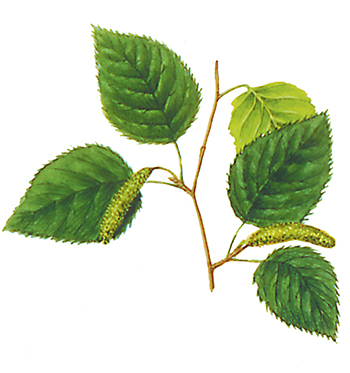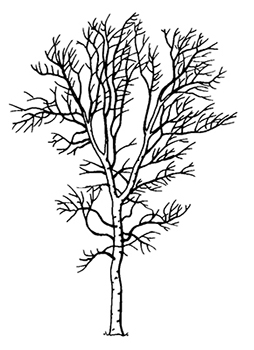Saskatchewan's provincial symbols
One of Canada’s three Prairie Provinces, Saskatchewan is bordered on the west by Alberta and on the east by Manitoba.
Origin of the name
The Cree name for the Saskatchewan River was “Kisiskatchewanisipi,” meaning “swift-flowing river.” Through common use, this eight-syllable name was shortened to Saskatchewan. In 1882, it became the name of one of the districts of the Northwest Territories.
Population (2006): 985,400
Area: Land – 570,700 km2Fresh water – 81,630 km2Total – 652,330 km2Capital: ReginaDate of entry into Confederation: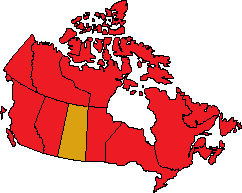
History
Saskatchewan was originally inhabited by First Nations of the Athapaskan, Algonquian and Siouan linguistic groups. Three Athapaskan nations lived in the north: the Chipewyan, the Beaver and the Slavey. Two Algonquian nations — the Cree and the Blackfoot — occupied the central part of the province. The south was inhabited predominantly by the Siouan nations — the Assiniboine and the Gros Ventres. The influence of Aboriginal peoples in Saskatchewan is evident from the number of Aboriginal names given to places across the province.
Southern Saskatchewan was relatively untouched by Europeans for many years because the prairie – which makes up much of the province – was of little monetary interest to the early fur traders. The northern wooded regions, on the other hand, were dotted with fur trading posts early in Canadian history. The first explorer was Henry Kelsey, an employee of the Hudson’s Bay Company who followed the Saskatchewan River into the plains of Saskatchewan around 1690.
Both Britain and the Province of Canada sent expeditions in the mid-1800s to explore the area and assess its agricultural potential. The Dominion Lands Act of 1872, combined with legislation to stimulate immigration, strongly encouraged homesteaders in Saskatchewan. In the 1880s, the newly constructed Canadian Pacific Railway brought settlers to farm the rich land. A great wave of immigration from Eastern Europe swept across the area in the late 19th and early 20th centuries.
In 1905, the province of Saskatchewan was formed by joining parts of the districts of Saskatchewan, Athabaska and Assiniboia. It became the only province with boundaries not based on any particular geographical features. Saskatchewan and its neighbouring province of Alberta also share the distinction of being the only Canadian provinces that are not bordered by salt water.
Agriculture – particularly wheat and other cereal crops, but also oilseeds and livestock – continues to be the mainstay of the Saskatchewan economy. The province has 40 percent of Canada’s farmland and produces 60 percent of the country’s wheat.
However, the economy is increasingly diversified thanks to the wealth of mineral resources: Saskatchewan has half the world's potash reserves, Canada’s largest heavy oil reserves, coal, gold, and rich uranium deposits. The one million inhabitants of Saskatchewan, about 3.3 percent of Canada’s population, reflect the ethnic diversity of Aboriginal, British, German, Ukrainian, Scandinavian, French and other peoples. The largest city is Saskatoon, which has a population of 219,000. Regina, the seat of government, has a population of 193,000.

Coat of arms
Saskatchewan’s shield of arms was granted in 1906 by King Edward VII. The crest, supporters and motto were granted in 1986 by Queen Elizabeth II.
The top of the shield of arms features a red lion, a traditional royal symbol, on a horizontal gold band; the middle and lower parts of the shield feature three gold wheat sheaves on a green background, symbolizing Saskatchewan’s agriculture and resources.
The shield is supported by a royal lion and a white-tailed deer, an animal indigenous to Saskatchewan. Both supporters wear collars of Prairie Indian beadwork. From each collar hangs a badge in the form of the six-pointed star (stylized lily) of the Saskatchewan Order of Merit. The badge worn by the lion displays Canada’s emblem, the maple leaf, while the badge worn by the deer displays Saskatchewan’s official flower, the western red lily.
Immediately above the shield is a helmet, which represents Saskatchewan’s co-sovereign status within Confederation. The helmet is decorated with mantling in Canada’s national colours – red and white. Above the helmet is a wreath that supports a beaver – Canada’s national animal. The beaver represents the North, the fur trade and the province’s native peoples. The beaver holds a western red lily, the floral emblem of the province. The Crown, a symbol of Saskatchewan’s direct link with the Sovereign through the lieutenant governor, surmounts the beaver at the top of the coat of arms.
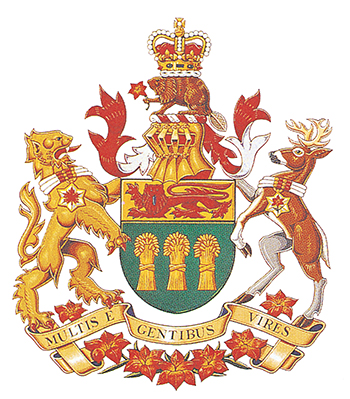
Motto
Multis e gentibus vires (From many peoples strength)
Flag
Saskatchewan’s flag was adopted by the province’s legislative assembly and proclaimed by the lieutenant governor in 1969. The flag is divided horizontally into two equal parts – one green, one gold. The green represents the northern forests of the province and the gold symbolizes the southern grain fields.
The Saskatchewan shield of arms is in the upper left quarter of the flag near the staff. The provincial floral emblem, the western red lily, is positioned on the fly half of the flag. The flag is based on a design by Anthony Drake, whose submission was chosen in a provincial design competition. The flag’s proportions are two by length and one by width.
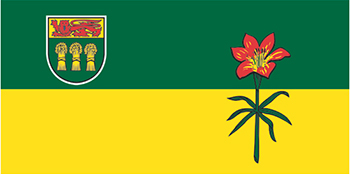
Floral emblem
Saskatchewan’s floral emblem, the western red lily (Lilium philadelphicum), was officially adopted in 1941. The Saskatchewan Natural History Society suggested the flower to a special committee created to consider the matter.
The flower is a protected species and grows in moist meadows and semi-wooded areas. It stands out brilliantly with its flaming red blossoms against a natural green background.
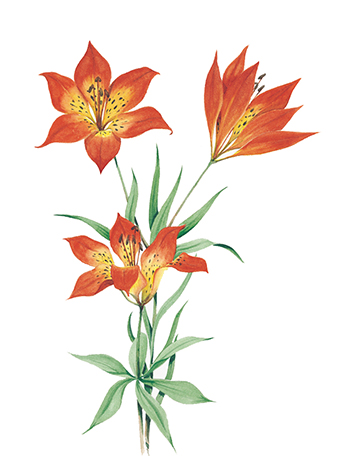
Other provincial symbols
Animal
Adopted as the official animal emblem for the province in 2001, the white-tailed deer (Odocoileus virginianus) is one of Saskatchewan’s most popular game animals.
Found throughout much of the province, the deer – commonly called the whitetail – is recognizable by the characteristic white underside to its tail. The white-tailed deer first appeared in Saskatchewan emblems as an element of the armorial bearings proclaimed in 1986.
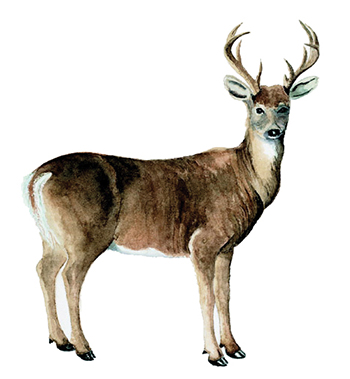
Bird
The sharp-tailed grouse (Pedioecetes phasianellus james) was adopted as Saskatchewan’s official provincial bird in 1945. Also known as the prairie chicken, is one of Saskatchewan’s most popular game birds.
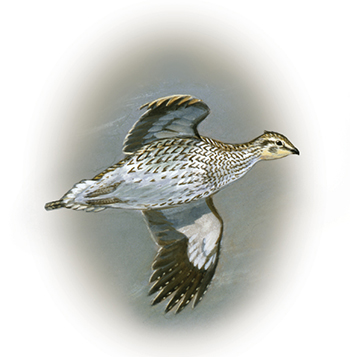
Fish
In 2005, a provincial fish emblem contest garnered 10,000 votes and the walleye (Sander vitreus) was named as Saskatchewan’s overwhelming choice.
Saskatchewan is known for its world-class fresh water fishing. In January 2005, a walleye measuring 36.5" in length, 22.5" in girth and 18.3 pounds was caught in the frozen waters of Tobin Lake. In 2014, a 13.3-pound walleye was caught spearfishing on the South Saskatchewan River north of Lake Diefenbaker; it has been recognized by the International Underwater Spearfishing Association as a record.
Fruit
Named a provincial emblem in 2005, the Saskatoon berry (Amelanchier alnifolia) is a sweet berry that has long been eaten by Canada’s native peoples.
The name derives from the Cree noun “misâskwatômina”, which translates to “the fruit of the tree of many branches.” The city of Saskatoon is also named after this plant.
Grass
Needle-and-thread grass (Stipa comata) was officially adopted as the provincial grass emblem in 2001.
The provincial grass emblem was selected by a coalition of environmental, wildlife and agricultural organizations through the Prairie Conservation Action Plan, seeking to sustain the native prairie ecosystem in a healthy state. Needle-and-thread grass was chosen because it is the dominant grass of Saskatchewan’s mixed grassland eco-region. It is also common in the moist mixed grassland and aspen parkland eco-regions.
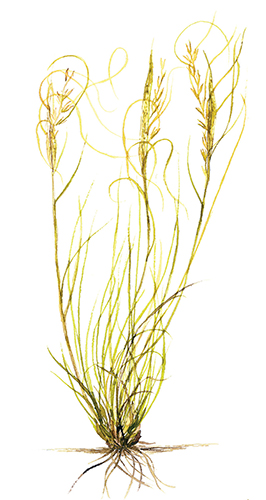
Mineral
Potash, or sylvite, was made the official mineral of Saskatchewan in 1997 following a province-wide competition open to grade 8 students.
Sylvite is the mineral name for the chemical compound kCi (potassium chloride), commonly called potash. Potash ore is a mixture of sylvite, with lesser amounts of carnallite, halite and traces of hematite oxide (responsible for the characteristic pink to reddish-brown colour) and clay.
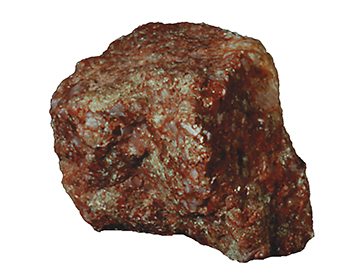
Sport
In recognition of the significance of curling for Saskatchewan and the international contribution of Saskatchewan curlers to the sport, curling was adopted as the province’s official sport in 2001.
Curling has been played in what is now Saskatchewan since the 1880s. Saskatchewan has been home to some of the best curlers in the world, including winners of Canadian championships, world championships, the first women’s world championships and the first Olympic gold medal in curling.
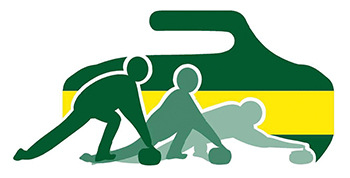
Tartans
Saskatchewan has two official tartans – the Saskatchewan District Tartan and the Saskatchewan Dress Tartan.
Registered in 1961 with the Court of the Lord Lyon, King of Arms of Scotland, the Saskatchewan District Tartan is a two-block tartan with seven different shades: gold to represent prairie wheat, brown for summer fallow, green for the forests, yellow for canola and sunflower, red for the western red lily, white for snow, and black for coal and oil.
The Saskatchewan Dress Tartan was introduced in 1997 for competitive highland dancers on the occasion of the Canadian Interprovincial Highland Dancing Championships held that year in Regina. It is a variant of the Saskatchewan District Tartan, with the off-white line of the original tartan becoming the background colour of the dress version.
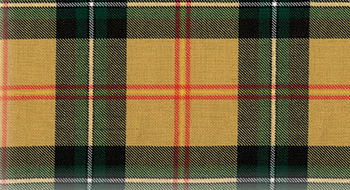
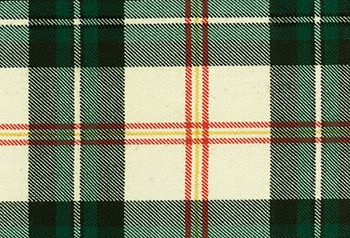
Tree
Adopted as a provincial symbol in 1988, the white birch (Betula papyrifera) can be easily recognized by its papery white bark.
First Nations communities used it to make canoes, baskets and utensils. The birch can also be used as a veneer or plywood, and it is a popular choice for furniture. The tree is found everywhere in Saskatchewan.
